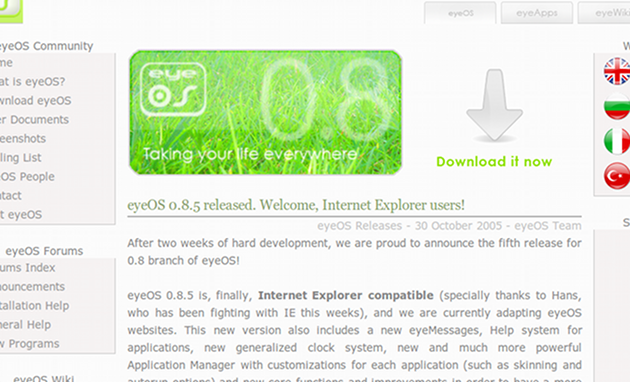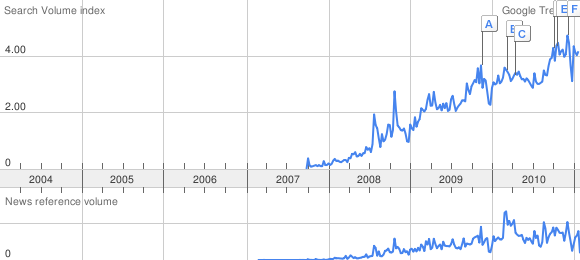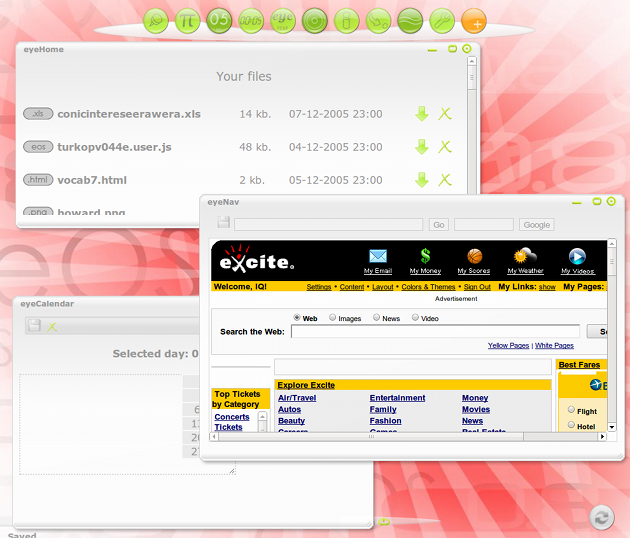Blast from the past: The “cloud” five years ago
Wednesday, 2 February 2011
I was cleaning out some miscellaneous files from my computer today when I found a folder called “eyeos”. EyeOS. My friend and I thought we were uber-cool when we set up eyeOS on our shared hosting accounts and looking back, yeah, well, we were.
EyeOS was an ambitious open-source project to give you a desktop in your browser. You could have files, record appointments, and write documents from anywhere, as long as you had an Internet-connected computer. Nothing was stored on your local hard drive, it was all up on the … Internet.
This was November, 2005. This was back when clouds meant fewer UV rays.
EyeOS really was quite cool for its time. You could set it up for multiple users, and each person would have their own file store, in which they could upload any file they wanted to. Users on the same system could edit a group note board to share messages to everybody or send direct mail to other users. There was even an Internet browser application, which, of course, was totally useless because it was just a glorified iframe.
And if that wasn’t enough, you could install more eyeApps or write your own!
Certainly, eyeOS wasn’t the only project chasing those nebulous clusters of moisture in the sky. Back in those days, the concept was called a “WebOS” (note how these -OS names were picked up for cellphone operating systems?), which was really something of a revival movement of the web desktop pioneered by the Desktop.com flop. There were many options, but they pretty much all sucked in some way or another, as this review of 10 webOSes showed (check out that screenshot of Orca!).
The term “WebOS” goes back a bit further than Desktop.com, to a project started by UC Berkeley and also worked on by Duke. The original WebOS was described as providing “basic operating systems services needed to build applications that are geographically distributed, highly available, incrementally scalable, and dynamically reconfiguring.” Holy time-paradoxes Batman! If only they had come up with a catchy, meaningless name like “cloud”…
I never used eyeOS much after I installed it. I did use it to store files so I could access them at school and at home, but it just wasn’t something that filled any needed gap. By 2006, Gmail had become popular and was a convenient way to store files in the fluff (remember GMail Drive?). And even if it weren’t for Gmail, since I had a shared host that I was running eyeOS on, I could just store files there with FTP anyways. If you look at some of the contemporary Slashdot comments, you’ll find that they’re all from bitter old men sitting on their porches yelling at kids to get off their lawn. And history has proven them correct. There was no point to using a laggy, feature-less Javascript emulation of windows and icons on a desktop in a browser window. But it was cool.
EyeOS continues to be developed and marketed as a Rich Internet Application (can’t you just feel the buzz in those words?), but since November 2005, Google et al. have been the ones pushing the boundaries of Internet computing and commoditizing the native platforms. There is one key advantage of eyeOS over Google Apps, and that is that since it’s open source, you can host eyeOS yourself and control your own data. But if you host it yourself, is it still in the cloud?



